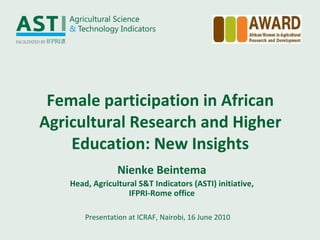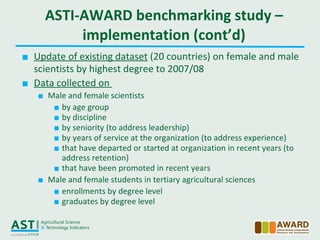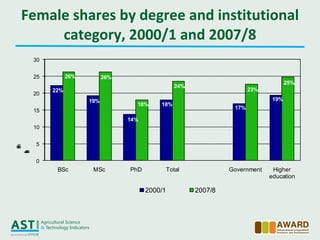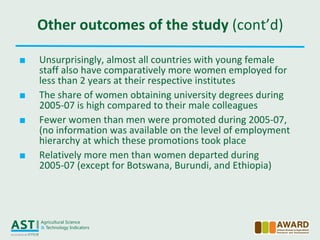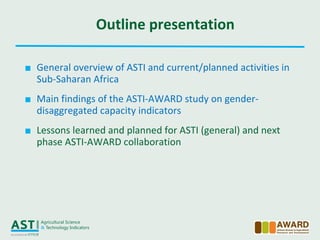Asti at award june2010
- 1. Female participation in African Agricultural Research and Higher Education: New Insights Presentation at ICRAF, Nairobi, 16 June 2010 Nienke Beintema Head, Agricultural S&T Indicators (ASTI) initiative, IFPRI-Rome office
- 2. General overview of ASTI and current/planned activities in Sub-Saharan Africa Main findings of the ASTI-AWARD study on gender-disaggregated capacity indicators Lessons learned and planned for ASTI (general) and next phase ASTI-AWARD collaboration Outline presentation
- 3. Important to measure and monitor inputs, outputs, and performance of agricultural S&T systems Important tool to assess the contribution of agricultural S&T to agricultural and overall economic growth Assist R&D managers and policymakers in policy formulation and decision-making But national S&T indicators are still scarce in developing countries and, when available, difficult to extract agricultural S&T indicators Relevance of agricultural S&T indicators
- 4. Objective : To provide internationally comparable information on investment, capacity, and institutional environments surrounding agricultural R&D, thereby informing and improving research policy Collaborative network with large number of national, regional and international partners; facilitated by IFPRI Collects national-level investment and capacity data on agricultural R&D: Focused on developing countries Through institutional survey rounds (primary data) Data coverage includes government, higher-education, nonprofit and business sectors Agricultural S&T Indicators (ASTI) Initiative
- 5. Aim is to provide: • Trends (to measure progress/digress over time) • Comparative information (higher/lower relative to others) across countries and regions Dataset includes country and regional-level trends Focus on input indicators Outputs: country briefs, regional and global reports, datasets, data fact sheets, analytical reports, news and updates, ASTI data tools (all available on www.asti.cgiar.org) ASTI has provided inputs in many influential initiatives (WDR-08, IAASTD, GCARD-2010) ASTI initiative (cont’d)
- 6. Portfolio of ASTI data at country level
- 7. ASTI outputs for Sub-Saharan Africa Country notes Data in-focus sheets Sub-regional briefs Regional brief and report and report Updated datasets and country profiles Country seminars ASTI website (Data Tool, country pages)
- 8. ASTI country pages Datasets available in ASTI Data Tool Data in-focus sheets Country note and previous ASTI country pubs Country profile (incl. directory with contact information) Additional(non-ASTI) resources on agricultural and food R&D
- 9. ASTI’s range of stakeholders (national, regional, international)
- 10. Involvement of sub-regional organizations (ASARECA, CORAF, SADC) Collaborators: mostly national agricultural R&D agencies (in few cases consultants) (Kenya-KARI) Improved country coverage (38 initiated, 5 ???) West Africa (15-16): Benin, Burkina Faso, Congo (Republic of), Cote d’Ivoire, Gabon, the Gambia, Ghana, Guinea, Mali, Mauritania, Niger, Nigeria, Senegal, Sierra Leone, Togo (no responses so far: Cameroon) East Africa (7-9): Burundi, Eritrea, Ethiopia, Kenya, Sudan, Tanzania, Uganda (no responses so far: DR Congo, Rwanda) Southern Africa (11-13): Botswana, Lesotho, Madagascar, Namibia, Malawi, Mauritius, Mozambique, Seychelles, South Africa, Zambia, Zimbabwe (no responses so far: Angola, Swaziland) Current ASTI survey round in Sub-Saharan Africa
- 11. Expansion: Strengthening analytical capacity Improving the use, understanding, and expansion of the ASTI data collection by stakeholders by stimulating further analysis: Build internal analytical capacity Link ASTI to various other institutions and researchers at country, regional, and global levels Capacity building at country level, where capacity to collect and analyze ASTI data is limited (in partnerships) Building this capacity will ensure better quality data, fill the current analytical gap, improve long-term sustainability of ASTI, and increase the reach, advocacy and policy relevance of the data
- 12. General overview of ASTI and current/planned activities in Sub-Saharan Africa Main findings of the ASTI-AWARD study on gender-disaggregated capacity indicators Lessons learned and planned for ASTI (general) and next phase ASTI-AWARD collab oration Outline presentation
- 13. International efforts to measure female participation in S&T Women are still underrepresented in (agricultural) S&T systems in most countries Increased participation of women important for gender-balance but also in order to tap substantial additional S&T resources Gender-disaggregated information on participation in S&T, over time and across countries, is key for national and international decision-makers Information remains scare, and when available, they do not always use common data methodologies and collection approaches
- 14. International efforts to measure female participation in S&T (cont’d) Since mid-1990s more attention to benchmarking gender-disaggregated S&T human resources To facilitate cohesion, UNESCO developed a toolkit on gender indicators in science, engineering, and technology (published in 2007) Number of international efforts have been ongoing: UNESCO, NSF, European Union/Eurostat ( She Figures series) Focus on agricultural sector: G&D CGIAR surveys, ASTI
- 15. ASTI-AWARD benchmarking study – implementation Goal : 155 agencies targeted in 19 sub Saharan African countries (excl. Sudan) – include largest government/nonprofit research and higher education agencies in each country Coverage : between 62% of research staff measured in 2000/1 (Nigeria) to more than 90% (Malawi, Mali, Mauritania, Niger, and Uganda) Outcome : 135 survey returns (87% of targeted) / sufficient coverage in 15 countries (totaling 125 agencies) Outputs : Country fact sheet, summary brief, detailed report (available on http://www.asti.cgiar.org/gender-capacity)
- 16. ASTI-AWARD benchmarking study – implementation (cont’d) Update of existing dataset (20 countries) on female and male scientists by highest degree to 2007/08 Data collected on Male and female scientists by age group by discipline by seniority (to address leadership) by years of service at the organization (to address experience) that have departed or started at organization in recent years (to address retention) that have been promoted in recent years Male and female students in tertiary agricultural sciences enrollments by degree level graduates by degree level
- 17. ASTI-AWARD benchmarking study – implementation (cont’d) Methodology and definitions are, in general, similar to the overall ASTI data collection activities But: measurements of S&T professionals: in headcounts (stocks and flows) or full-time equivalents (volume of S&T) – following international standards for measuring S&T human resources Translated in numbers: the 125 agencies employed 8,258 professional staff, which is 5,899 measured in full-time research equivalents
- 18. Overall growth in professional staff in headcounts by gender, 2000/1 to 2007/8
- 19. Female shares by degree and institutional category, 2000/1 and 2007/8
- 20. Female shares in professional staff by country, 2000/1 to 2007/8
- 21. Gender-disaggregated shares by degree level, 2000/1 to 2007/8
- 22. Distribution of female professional staff by age group, 2007/8
- 23. Shares of female students enrolled and graduated, 2007
- 24. Shares of female students enrolled and female in professional staff, 2007/8
- 25. Shift in gender gap with career advancement (10 countries), 2007/8 PS/TS indicates professional and technical support staff; SPL includes scientists, (assistant) professors, and (senior) lecturers not in management positions; and M indicates management and includes directors, deans, and department heads. When including all 15 countries, the female share in management positions is lower at 14 percent
- 26. Other outcomes of the study Proportion of women employed in food and nutritional science was considerably higher (44%) than the share of women employed in other fields of agriculture. Relatively more women were also trained in biodiversity (30%), molecular biology (31%), and agricultural economics (24%) In contrast, shares of professional women were particular low in disciplines related to engineering, such as water and irrigation (8%), forestry (15%), and soil science (13%) Female shares in agricultural research in Africa are, on average, slightly higher than in Asia and Middle East/North Africa, but lower than in Latin America. In all region there are large differences across countries
- 27. Other outcomes of the study (cont’d) Unsurprisingly, almost all countries with young female staff also have comparatively more women employed for less than 2 years at their respective institutes The share of women obtaining university degrees during 2005-07 is high compared to their male colleagues Fewer women than men were promoted during 2005-07, (no information was available on the level of employment hierarchy at which these promotions took place Relatively more men than women departed during 2005-07 (except for Botswana, Burundi, and Ethiopia)
- 28. General overview of ASTI and current/planned activities in Sub-Saharan Africa Main findings of the ASTI-AWARD study on gender-disaggregated capacity indicators Lessons learned and planned for ASTI (general) and next phase ASTI-AWARD collaboration Outline presentation
- 29. How has the ASTI-AWARD study influenced ASTI’s overall activities? Increase the country coverage for Africa — New data on FTE researchers and technicians by degree and by gender for about 34 countries in Sub-Saharan Africa Using a definition of “researchers” is excluding an (increasing?) pool of other professional staff with university degrees in some countries — Additional survey question to collect information on technical staff and their educational level Need to address better major capacity challenges such as retention, aging staff — In-depth studies on capacity developments in Sub-Saharan Africa planned
- 30. Lessons learned for next phase ASTI-AWARD collaboration More detailed information is needed on the exact pool of researchers (degree levels by age group by gender) Need to interview (main) respondents to improve data quality and also obtain feedback on why certain trends have taken place Need additional qualitative information to better understand the institutional, social, and political environments surrounding professional women in agricultural research and higher education Find better indicators to obtain information on the mobility within agencies (retention and entry) Better link with AWARD’s overall M&E component, including statistics on application and fellowship pool
- 31. Thank you Please visit www.asti.cgiar.org & astinews.wordpress.com

